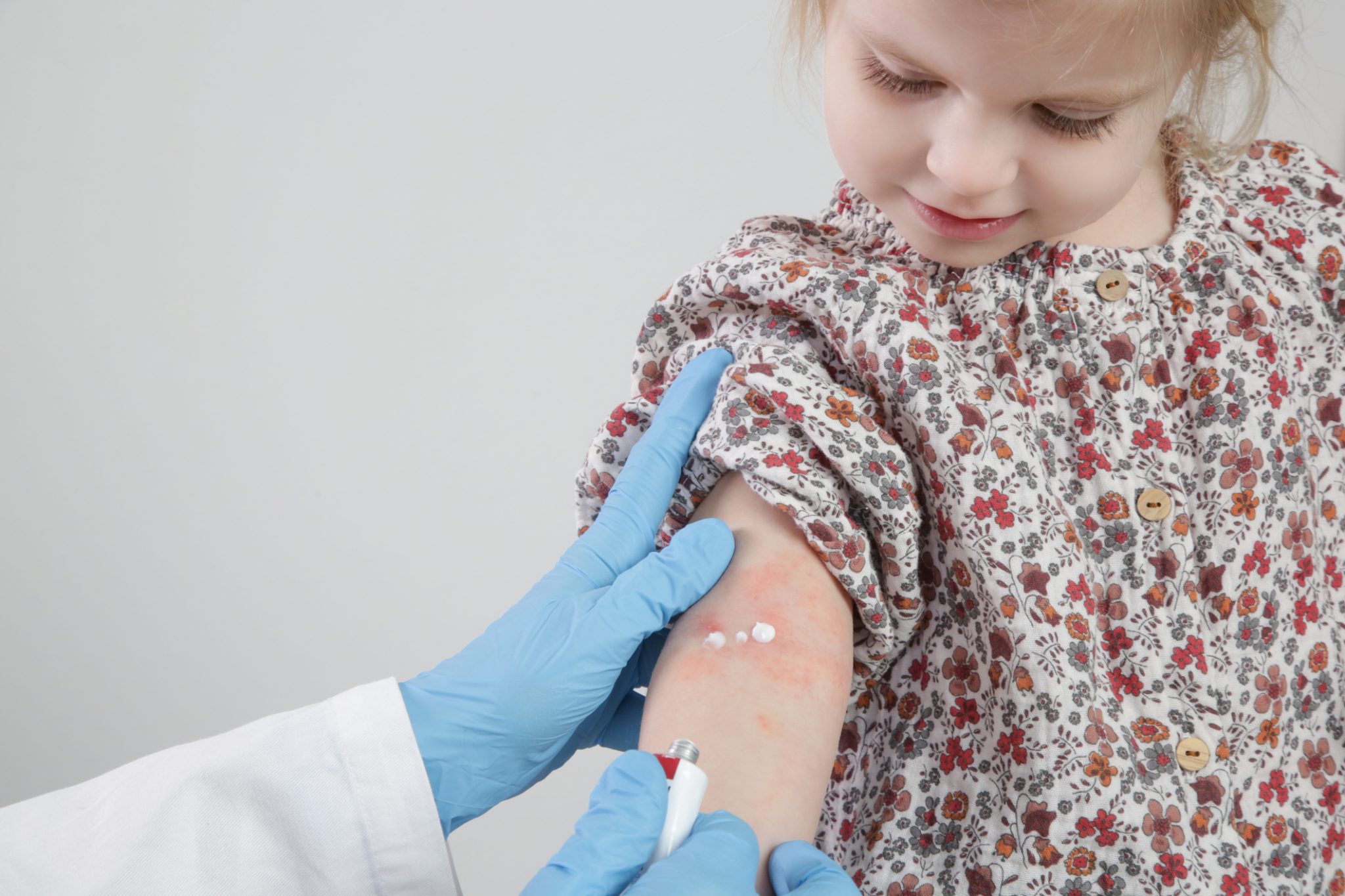Tiny hands exploring the world suddenly erupt in a rash that causes endless scratching and tears. This is the reality for many families grappling with pediatric contact dermatitis, where everyday items turn from harmless to harmful.
The relentless itching and redness of contact dermatitis can steal sleep, disrupt school, and turn joyful moments into stressful ordeals. Unlike eczema, an internal battle, contact dermatitis is a direct clash between your child’s skin and the outside world. To win this battle, we need to unmask the triggers lurking in everyday items.
Let’s explore these common culprits, delving into safe home testing methods and learning when to call in the professionals, all to restore your child’s comfort and protect their precious skin.
What is Pediatric Contact Dermatitis?
Contact dermatitis occurs when the skin reacts negatively to a substance it touches. This reaction can manifest in two primary forms:
- Irritant Contact Dermatitis: This is the most common form and results from direct damage to the skin’s outer layer by a harsh substance.
- Allergic Contact Dermatitis: This occurs when the skin develops an allergic reaction to a specific allergen. The immune system overreacts, leading to inflammation and rash.
How Long Does Contact Dermatitis Last?
Wondering when that itchy rash will finally disappear? The answer, unfortunately, isn’t so simple. Think of contact dermatitis as a stubborn house guest: its stay depends on a few factors. If it’s a minor irritation and you quickly kick out the culprit, you might see clear skin within a week.
But if it’s a full-blown allergic reaction, or if your child keeps encountering the trigger, you could be looking at weeks, or even months, of discomfort. Basically, the faster you find the trigger, the sooner you’ll see relief.
8 Common Triggers of Contact Dermatitis in Children
Children are particularly susceptible to contact dermatitis due to their delicate skin and frequent exposure to various substances. Here are some of the most common triggers:
1. Soaps & Detergents
Many children experience irritation from harsh soaps, bubble baths, and laundry detergents, as these products can strip away the skin’s protective oils, leaving it vulnerable.
Opting for fragrance-free and hypoallergenic alternatives can significantly reduce the risk of contact dermatitis. Parents should carefully examine product labels to ensure they are selecting gentle options.
2. Fabrics
The texture and composition of certain fabrics, such as wool and synthetic materials, can be too abrasive for a child’s sensitive skin, leading to redness and itching.
To minimize discomfort, choose clothing and bedding made from natural, breathable materials like cotton, which allows the skin to breathe. This simple change can make a huge difference in a child’s comfort.
3. Jewelry
Nickel, common in many jewelry pieces, is a frequent culprit behind allergic reactions in children. Even items labeled “hypoallergenic” may contain trace amounts of this metal, which can trigger dermatitis. When selecting jewelry for children, prioritize nickel-free options to prevent skin irritation.
4. Personal Care Products
Lotions, shampoos, and sunscreens, while essential for hygiene and sun protection, can sometimes contain fragrances, preservatives, and other chemicals that irritate a child’s delicate skin. Parents should thoroughly review ingredient lists and select products specifically formulated for sensitive skin. A patch test is always advisable before consistent use.
5. Plants
Plants like poison ivy, poison oak, and poison sumac are notorious for causing allergic contact dermatitis, leading to intense itching and blistering. Often curious and active outdoors, children are particularly susceptible to these plants. Educating children about plant identification and taking precautions during outdoor activities is crucial for prevention.
6. Toys & Play Materials
The materials used in toys and play items, such as certain plastics, dyes, and glues, can sometimes irritate a child’s skin. Parents should look for toys labeled as non-toxic and avoid those with strong chemical odors. Regularly cleaning toys can also help minimize exposure to potential irritants.
7. Saliva
Constant drooling, especially common in babies and toddlers, can lead to significant skin irritation around the mouth. This occurs because saliva contains enzymes that can break down the skin’s protective barrier. Gentle cleansing and applying barrier creams can help protect the skin from this type of contact dermatitis.
8. Diapers
Diaper rashes, a common form of irritant contact dermatitis, can be triggered by the materials used in diapers and prolonged exposure to moisture. Choosing diapers with breathable materials and changing them frequently are essential for prevention. Applying barrier creams can also create a protective layer, shielding the skin from irritants.
How to Identify Contact Dermatitis Triggers
Identifying the triggers of contact dermatitis in children can involve a combination of at-home observation and professional testing. While some initial steps can be taken at home, always prioritize consulting with a pediatric dermatologist, especially before initiating any form of patch testing. Home-based observation may identify potential triggers, but it should be done with caution and careful documentation.
Home-Based Observation
- Isolate Suspected Items: Begin by pinpointing any new products or materials your child has recently encountered.
- Limited Exposure: If a specific product is suspected, apply a small amount to a small, discreet area of the skin (e.g., the inside of the forearm) for a short period.
- Observe and Document: Carefully monitor the application site for any signs of redness, itching, or rash over the next 48-72 hours. Record your findings, including the time of application and any observed reactions.
- Sequential Testing: Test only one substance at a time to isolate the potential trigger accurately.
- Caution: Never apply potentially strong irritants or allergens to large skin areas. Immediately discontinue testing if a severe reaction occurs.
When It’s Time for Professional Allergy Testing
Pinpointing the source of contact dermatitis can feel like detective work, with clues scattered around your home. Initial observations might offer some insights, but persistent or severe cases often require a professional’s expertise.
When home remedies and guesswork leave you frustrated, it’s time for definitive answers. Professional allergy testing, including precise patch testing, can reveal the hidden triggers causing your child’s discomfort, bringing clarity where uncertainty once prevailed.
Moreover, a pediatric dermatologist can distinguish contact dermatitis from other skin conditions that might be masquerading as the real deal. And if your DIY testing is just making things worse, put down the patch and reach out to a professional—it’s the safest, most effective way to find real relief.
Find Lasting Relief From Contact Dermatitis at Skin MD
Contact dermatitis can turn your child’s world upside down, leaving them (and you!) frustrated and uncomfortable. But here’s the good news: you don’t have to face this alone. Skin MD Chicago offers expert diagnosis to pinpoint the exact triggers, personalized treatment plans tailored to your child’s sensitive skin, and professional patch testing to get to the root of the problem.
We’ll help you identify irritants, recommend gentle skincare routines, and provide the ongoing support you need to see your child’s skin thrive. Schedule a consultation with Skin MD today, and let’s work together to restore your child’s comfort and bring back those happy smiles.
Happy, Healthy Skin for Your Little One: Chicago’s Pediatric Derm Experts
Is your child’s skin causing worry beyond the occasional rash? At Skin MD Chicago, we know that childhood skin issues can vary widely, from common irritations like diaper rash and cradle cap to complex conditions like eczema, psoriasis, and even viral bacterial infections. Our board-certified pediatric dermatologists provide expert diagnoses and create personalized treatment plans to address your child’s individual needs, all within a supportive and comforting environment.
Don’t let skin concerns hold your child back—schedule an appointment with our team today and let us help them achieve healthy, happy skin.



